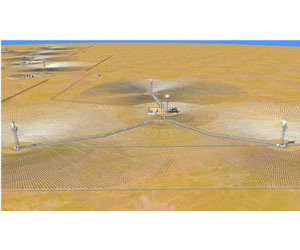 The Rush for Gigawatts in the Desert ExplodesJan 9, 2009 Ucilia Wang - greentechmedia.com
There might be a credit crunch, but that's not stopping solar companies from trying to lay claim to millions of acres of desert real estate. The federal Bureau of Land Management has seen a 78 percent jump in the number of solar energy project applications since it reversed a controversial decision last July and started to accept applications again. The number of applications has risen to 223 from 125. The applicants are vying to build solar power plants that are 10 megawatts or larger in California, Arizona, Nevada, New Mexico, Utah and Colorado, according to the BLM data provided by Andrew Malone in the agency's public affairs office. In all, these projects would occupy 2.3 million acres. It's difficult to say what the total power generation capacity that has been proposed is since some developers have yet to specify that information on their applications. Many of the proposals call for building projects with hundreds of megawatts of generation capacities. "I didn't realize they had gotten that many," said David Briery, a spokesman for BLM's Desert District in California. Briery isn't so surprised by the high number of projects being proposed in his district, home to the Mojave Desert and other vast tracks of sunny, rural land (see map for proposed solar energy projects). The BLM has listed on its Website 75 projects worth 51.6 gigawatts in the Desert District, but the numbers don't reflect the total applications it has received because the list isn't updated quickly (you can download an Excel file for the partial list on the BLM Website). Overall, there are 107 applications for the BLM land in California, 71 applications in Nevada and 35 in Arizona, Malone said. New Mexico, Utah and Colorado make up the rest. Although the BLM oversees 258 million acres of land in the country, many tracks are not suitable for power plant developments because they are too far from the transmission lines or don't receive enough hot, direct sunlight, which certain types of solar technologies call for. The rush of applications is a strong indication that entrepreneurs see gold in desert land. In fact, some locations are considered so desirable that several companies are lining up for the chance to develop the same plots. So if the first company fails, then the second applicant can step in, Briery said. Although the BLM has been flooded with solar energy proposals, it doesn't process them quickly. That's because the path to getting permits for build those power plants will involve lengthy environmental and other reviews by not only the BLM but also other federal and state agencies. "There's always a sharp fallout between the application stage and when a plant can be successfully permitted, designed and built. That's the big unknown," said John Geesman, a former member of the California Energy Commission and the current co-counsel of the American Council on Renewable Energy. Out of the 223 proposals, only 2 projects are far enough along to undergo environmental reviews, a critical juncture in the permitting process. The two projects come from BrightSource Energy in Oakland, Calif., and Stirling Energy Systems in Phoenix, Ariz. Both are proposing solar-thermal power plants which, unlike rooftop solar panels, use the sun's heat to generate electricity. BrightSource wants to build three solar-thermal plants totaling 400 megawatts in the Mojave Desert (see project description). The company has signed contracts with PG&E to deliver the power from the project. Stirling Energy is proposing a 750-megawatt solar-thermal power project to be located in Imperial County, which is south of the Mojave Desert (see project description). BLM will need more employees to review those applications promptly, Geesman said. But whether it will get the staffing boost from a new administration that portrays itself as a solar energy booster remains to be seen. "Until the new administration presents a budget, you are not going to know what the regional BLM staff is going to be," Geesman said. Given the strong interest in developing solar energy in California, the state has tried to streamline the permitting process. For example, it signed a memorandum of understanding with the BLM in late 2007 to jointly conduct environmental reviews of each project. That will help to speed up the process, but doing environmental reviews is an inherently time-consuming process that requires detailed assessments of each project's impact on wildlife and other natural resources, Geesman said. The BLM is drafting a document that it hopes will also speed up the permitting process. The document, called the Solar Energy Programmatic Environmental Impact Statement (PEIS), would carry out a comprehensive analysis of solar energy projects' potential environmental, social and economical impact. Each applicant will still have to carry out an environmental review of the project to gauge its specific impact, but the PEIS would serve as a reference. The PEIS, among other things, would identify land that is suitable for solar energy development and the best procedures and practices for approving projects. The need to do a PEIS is what prompted the BLM to stop accepting solar energy applications last year (see BLM Lifts Moratorium on Public Land for Solar). The PEIS was to take two years to complete, and the agency wanted to focus on getting the PEIS done before considering more projects. The agency has completed a PEIS for wind and geothermal energy developments. |
Email this page to a friend


